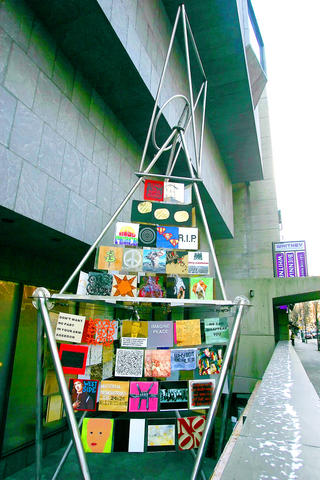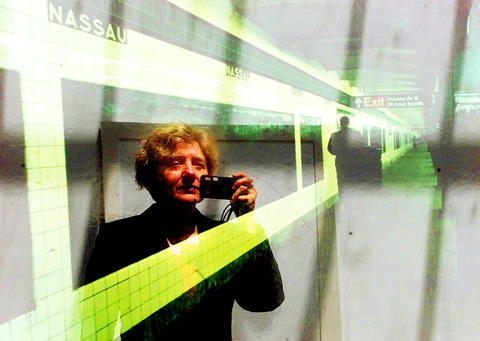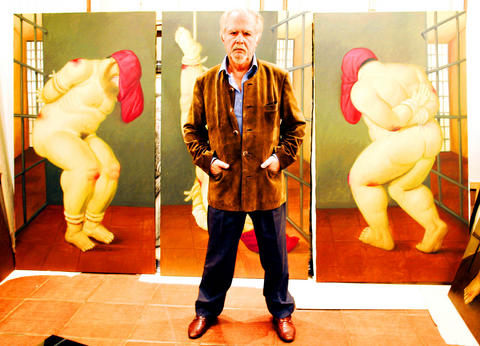It has inspired films, songs and writing. Now the war in Iraq is inspiring fine artists in numbers, perhaps, unprecedented in any war in history.
In studios from London to San Francisco, artists are struggling to interpret images of the world's most highly publicized war, in sculpture and canvasses, photographs and collages. And although artists responded slowly at first, the past 18 months has seen an explosion of art criticizing the conflict.
Last year one of the centerpieces of the Whitney Museum of American Arts Biennial in New York was a recreation of Mark di Suvero's 1966 Peace Tower - a commentary on the Vietnam war - which invited a new generation of artists to contribute panels.

PHOTO: NY TIMES NEWS SERVICE
In November, the huge cycle of paintings inspired by the torture scandal at Iraq's Abu Ghraib prison, by the Colombian figurative painter Fernando Botero, will be seen together for the first time at the American University Museum in Washington. It is one of a number of recent works dealing with Abu Ghraib, including a series of giant photographic reconstructions by the controversial West Coast artist Clinton Fein.
It is a sudden flowering of powerful protest art that has brought together artists of an older generation who can remember Vietnam, and a younger generation that on the whole has shied away from overtly political art. It is not just Di Suvero who provides a link. The American collagist Martha Rosler has reimagined the work that she produced in the 1960s addressing the impact of the war on the home front, while Gerhard Richter, one of Germany's most important living artists, has also tackled the war in a book of collages entitled War Cut.
But it is, perhaps, Botero's paintings, reminiscent in some respects of Francisco de Goya's Disasters of War, that is likely to be the most visible of the works emerging in opposition to the Iraq war.

PHOTO: NY TIMES NEWS SERVICE
"It is a testimony," Botero said. "I became obsessed with the paintings, spending 11 months doing nothing but work on them. When the first images emerged of Abu Ghraib I was so shocked that a country that presents itself as the model of human rights could do this. It is like a permanent accusation. In that respect art is both weak and strong."
And although selections from among the cycle of paintings have been shown in New York and Berkeley to good reviews, he is uncertain of the reception something so directly critical of the US will get in Washington, a very different city.
The curator of that exhibition, Jack Rasmussen, admits that he was surprised by the relatively slow response by artists to the war, particularly in Washington. "I think there is a sensitivity among artists to the risk of producing not art but political posters. I think people have felt it is not going to help their career, because it runs counter to prevailing trends in art. But people are now taking the risk."

PHOTO: NY TIMES NEWS SERVICE
And while Rasmussen is not convinced that art can effect a change to the political landscape, he agrees with Botero that it is important that today's artists bear witness.
"Art cannot change [the war] but it can bear a testimony. When people stop talking about it, the art is still there." And after the Botero exhibit, Rasmussen has two other exhibitions scheduled for next year - a presidential election year as he points out - that sees artists invited to respond to the war, using Goya's cycle, Disasters of War, as a starting point.
Mark Sladen, director of exhibitions at the Institute of Contemporary Arts (ICA) in London, who organized the Memorial to Iraq show earlier in the summer, has also been surprised at the slowness of artists in addressing Iraq, but now believes the conflict is inspiring an important transformation in the art world.
"One of the things that motivated me to do the show at the ICA was I felt the art world had been strangely quiet. I think there has been a bias against work seen as illustrative and dogmatic. It seems to me that situation is unfreezing and people are finding ways to express political issues that are not oversimplified.
"One of the key figures, I think, is the US artist Sam Durant who did a really nice piece for our show, proposing to pile up the debris of the war around Whitehall and the White House. Someone else is the Swiss artist Thomas Hirschhorn." Indeed, Hirschhorn's most recent work - Superficial Engagement - which some critics have compared to Picasso's Guernica, is a walk-in exhibit that includes hundreds of color images of Arabs and Afghans who have been blown to pieces.
"I think something really important is going on," says Sladen. "It is an important transitional moment, between the market-driven art world and artist pulling powerfully in a different direction."

April 28 to May 4 During the Japanese colonial era, a city’s “first” high school typically served Japanese students, while Taiwanese attended the “second” high school. Only in Taichung was this reversed. That’s because when Taichung First High School opened its doors on May 1, 1915 to serve Taiwanese students who were previously barred from secondary education, it was the only high school in town. Former principal Hideo Azukisawa threatened to quit when the government in 1922 attempted to transfer the “first” designation to a new local high school for Japanese students, leading to this unusual situation. Prior to the Taichung First

The Ministry of Education last month proposed a nationwide ban on mobile devices in schools, aiming to curb concerns over student phone addiction. Under the revised regulation, which will take effect in August, teachers and schools will be required to collect mobile devices — including phones, laptops and wearables devices — for safekeeping during school hours, unless they are being used for educational purposes. For Chang Fong-ching (張鳳琴), the ban will have a positive impact. “It’s a good move,” says the professor in the department of

On April 17, Chinese Nationalist Party (KMT) Chairman Eric Chu (朱立倫) launched a bold campaign to revive and revitalize the KMT base by calling for an impromptu rally at the Taipei prosecutor’s offices to protest recent arrests of KMT recall campaigners over allegations of forgery and fraud involving signatures of dead voters. The protest had no time to apply for permits and was illegal, but that played into the sense of opposition grievance at alleged weaponization of the judiciary by the Democratic Progressive Party (DPP) to “annihilate” the opposition parties. Blamed for faltering recall campaigns and faced with a KMT chair

Article 2 of the Additional Articles of the Constitution of the Republic of China (中華民國憲法增修條文) stipulates that upon a vote of no confidence in the premier, the president can dissolve the legislature within 10 days. If the legislature is dissolved, a new legislative election must be held within 60 days, and the legislators’ terms will then be reckoned from that election. Two weeks ago Taipei Mayor Chiang Wan-an (蔣萬安) of the Chinese Nationalist Party (KMT) proposed that the legislature hold a vote of no confidence in the premier and dare the president to dissolve the legislature. The legislature is currently controlled